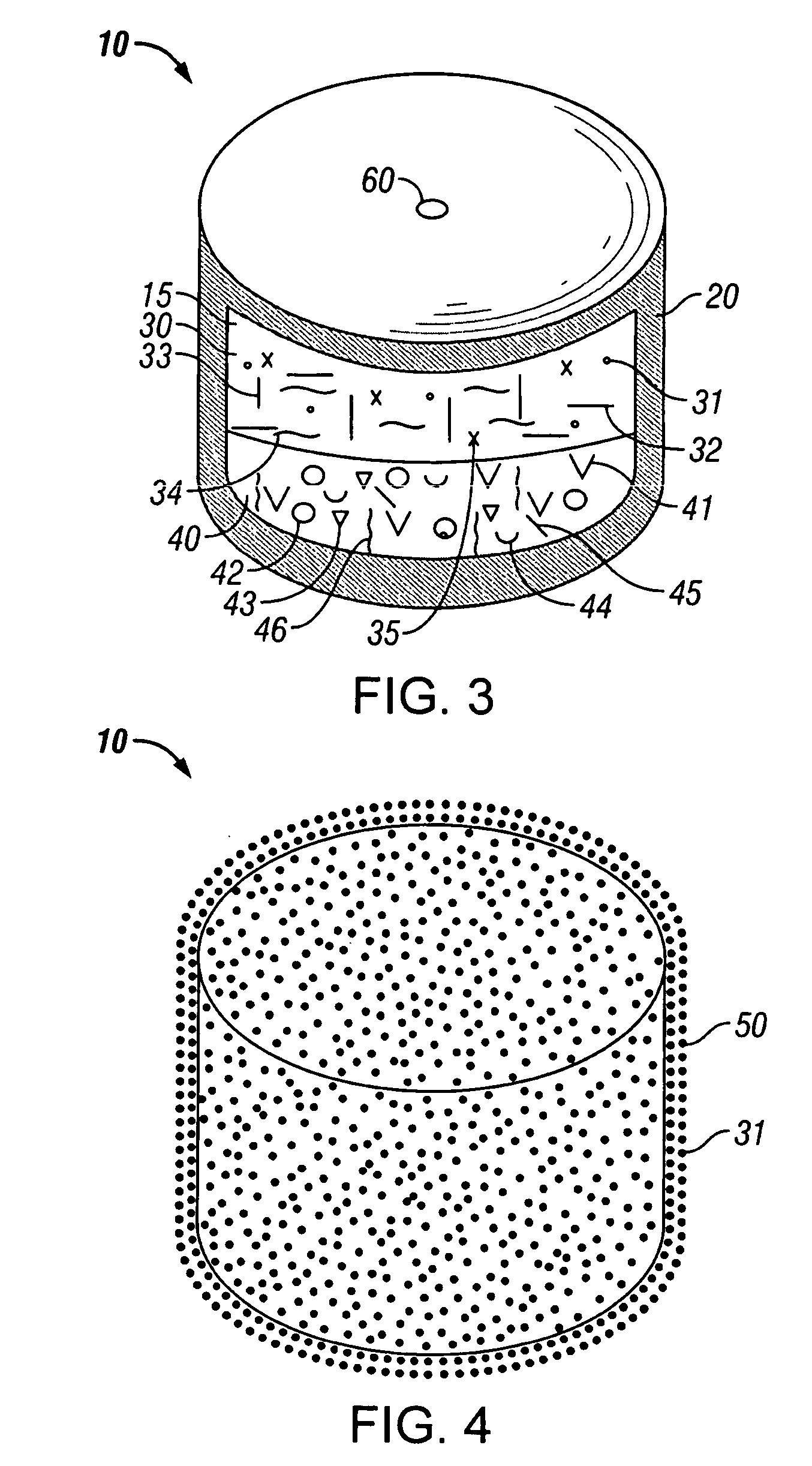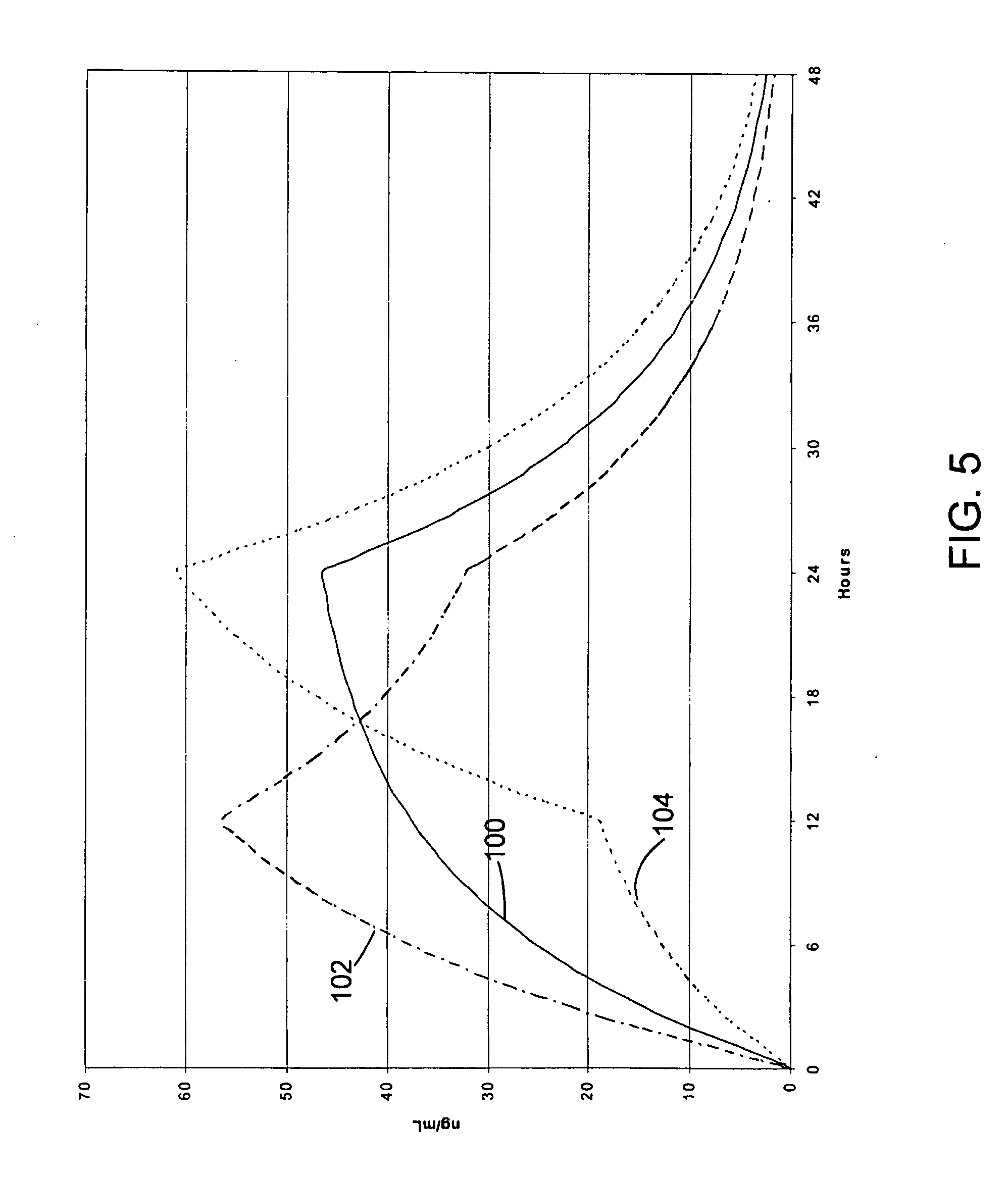Once-a-day, oral, controlled-release, oxycodone dosage forms
a technology of oxycodone and dosage forms, which is applied in the field of in vitro and in vivo profiles, can solve the problems of purdue pharma's biphasic oxycontin® product abuse problems, increased drug price, and increased drug pri
- Summary
- Abstract
- Description
- Claims
- Application Information
AI Technical Summary
Benefits of technology
Problems solved by technology
Method used
Image
Examples
example 1
Oxycodone Hydrochloride 17 mg Osmotic Push Pull Systems (Fast and Slow)
[0215] A dosage form adapted, designed and shaped as an osmotic drug delivery device was manufactured as follows: Two granulations were made by the following procedure: 1479 g of oxycodone hydrochloride, USP and 7351 g of polyethylene oxide N80 with average molecular weight of 200,000 were added to a fluid bed granulator bowl. Next a binder solution was prepared by dissolving 500 g of polyvinylpyrrolidone identified as K29-32 in 4500 g of water. The dry materials were fluid bed granulated by spraying with 1800 g of binder solution. Next, the wet granulation was dried in the granulator to an acceptable moisture content. The two granulations were then sized by passing through a 7-mesh screen into the same container. Next, the granulation was transferred to a blender and mixed with 3.53 g of butylated hydroxytoluene as an antioxidant and lubricated with 88 g of magnesium stearate.
[0216] Next, a push composition wa...
example 2
Oxycodone Hydrochloride 20 ml Osmotic Push Pull System
[0222] A dosage form adapted, designed and shaped as an osmotic drug delivery device was manufactured as follows: 1933 g of oxycodone hydrochloride, USP, 7803 g of polyethylene oxide N80 with average molecular weight of 200,000, and 200 g of polyvinylpyrrolidone identified as K29-32 having an average molecular weight of 40,000 were added to a fluid bed granulator bowl. Next a binder solution was prepared by dissolving 500 g of the same polyvinylpyrrolidone in 4500 g of water. The dry materials were fluid bed granulated by spraying with 2000 g of binder solution. Next, the wet granulation was dried in the granulator to an acceptable moisture content, and sized by passing through a 7-mesh screen. Next, the granulation was transferred to a blender and mixed with 2 g of butylated hydroxytoluene as an antioxidant and lubricated with 25 g of magnesium stearate.
[0223] Next, a push composition was prepared as follows: first, a binder s...
example 3
Oxycodone Hydrochloride 80 mg Osmotic Push Pull System
[0232] A dosage form adapted, designed and shaped as an osmotic drug delivery device was manufactured as follows: 34.36 kg of oxycodone hydrochloride, USP, 63.7 kg of polyethylene oxide N150 with average molecular weight of 200,000, and 0.02 kg of ferric oxide red, were added to a fluid bed granulator bowl. Next, a binder solution was prepared by dissolving 5.40 kg of polyvinylpyrrolidone identified as K29-32 having an average molecular weight of 40,000 in 49.6 kg of water. The dry materials were fluid bed granulated by spraying with 33.3 kg of binder solution. Next, the wet granulation was dried in the granulator to an acceptable moisture content, and sized by passing through a 7-mesh screen. The granulation was then transferred to a blender and mixed with 0.02 kg of butylated hydroxytoluene as an antioxidant and lubricated with 0.25 kg of magnesium stearate.
[0233] Next, a push composition was prepared as follows: First, a bin...
PUM
| Property | Measurement | Unit |
|---|---|---|
| Temperature | aaaaa | aaaaa |
| Fraction | aaaaa | aaaaa |
| Fraction | aaaaa | aaaaa |
Abstract
Description
Claims
Application Information
 Login to View More
Login to View More - R&D
- Intellectual Property
- Life Sciences
- Materials
- Tech Scout
- Unparalleled Data Quality
- Higher Quality Content
- 60% Fewer Hallucinations
Browse by: Latest US Patents, China's latest patents, Technical Efficacy Thesaurus, Application Domain, Technology Topic, Popular Technical Reports.
© 2025 PatSnap. All rights reserved.Legal|Privacy policy|Modern Slavery Act Transparency Statement|Sitemap|About US| Contact US: help@patsnap.com



